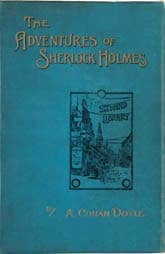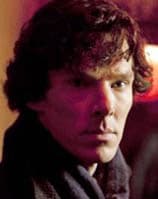The Adventures of Sherlock Holmes
Critique • Quotes • Text • Sherlock Holmes at the movies
 First edition
First editionFirst publication
1892
Literature form
Story collection
Genres
Crime, mystery
Writing language
English
Author's country
England
Length
Twelve stories, approx. 94,000 words

Martin Freeman's Watson, left, keeps Benedict Cumberbatch's sociopathic Holmes grounded.
Postmodern Sherlock
Sherlock (2010–2017): Television series, thirteen episodes, 85–90 minutes each; writers Mark Gatiss, Steven Moffat, Stephen Thompson; featuring Benedict Cumberbatch, Martin Freeman, Gatiss, Rupert Graves, Una Stubbs, Andrew Scott
And the radical revisions of the Sherlock Holmes story continue in the twenty-first century—with maybe the most eccentric variation yet.
A new series, simply titled Sherlock, was launched in 2010 for British TV and shown abroad. It quickly became a sensation and continued to be produced sporadically, working around the busy schedules of its two rapidly rising stars, for several years.
Two major differences about this series. (Actually there are dozens differences about it, but we'll focus on two.)
One, it takes place in contemporary London and involves a lot of current tech—mobile phones, social media, DNA testing—as crucial ingredients of the stories. This might seem to antiquate a lot of Holmes's special talents, but he still sniffs out criminals with his old-school skills, analyzing the varieties of mud, tobacco and so on. And he still plays his party trick of detecting everything about people by noting tiny details of their appearance and behaviour. (Remember, Sherlock Holmes is the original CSI-style sleuth.)
The second major difference that this Sherlock isn't just eccentric, as Benedict Cumberbatch plays him. He's practically a sociopath. Even calls himself one. He's a sociopath with Asperger syndrome, which is to say, a highly functioning, brilliant misfit.
Yet somehow, after an episode or two to get used to this weirdo, we warm up to him. This may have something to do with his Watson, played by Martin Freeman as everyman. He's a doctor still, but a veteran of the most recent post-9/11 war in Afghanistan rather than of the Anglo-Afghan war of the latter 1800s as Doyle wrote the character.
In the first episode, cutely titled "A Study in Pink", Watson meets Holmes in a manner similar to that in the first Sherlock Holmes story, "A Study in Scarlet". He gradually comes to appreciate his strange new friend, as in that original story. The televised episode then veers off in some very different directions, but always finding modern parallels to elements in Doyle's story. A Victorian hack driver, for example, is now a modern cabbie.
Subsequent episodes are each updated amalgams of original stories. But that won't be any help to you in trying to figure out what comes next. The plots are only tangentially related to Doyle's tales. The episode, "The Hounds of the Baskervilles" (yes, the canine plural is intended), for example, features few scenes on dark and misty moors but takes place for the most crucial scenes inside a psychological weapons testing laboratory.
The first meeting of Sherlock Holmes and Doctor Watson in 2010's updated Sherlock.
"The Reichenbach Fall" has nothing to do with Holmes and Moriarty tumbling over the waterfalls as in Doyle's "The Final Problem". It does feature a painting of the watery geographical feature in a small way, but the "fall" of the title refers to Holmes falling victim to a plot to expose him as a fraud and his apparent suicide by leaping off the roof of a building.
The re-imagined stories are told with a lot of jump cuts, montages, text waving across the screen, flashbacks, out-of-order sequences, and scenes that may or may not have happened.
It sounds like a mess but it works brilliantly, keeping you transfixed.
Other familiar Holmesian characters are present, though in some rather unfamiliar characterizations. The landlady Mrs. Hudson is an old dear as always, but watch for some startling revelations late in the series as to her real purpose.
Sherlock's brother Mycroft is a powerful, somewhat ominous presence in the background. For a long time we're never quite sure if he's looking out for Sherlock or working on the other side, whatever side that is.
Sherlock's "the" woman, Irene Adler, is introduced in "A Scandal in Belgravia" as a dominatrix with naughty pictures of the Royals on her phone. She and Sherlock get naked—though at different points—in this cheeky and very clever episode. And you'll never guess its aftermath—involving Pakistani terrorists.
Only in the final season does the show seem to stray too erratically from cerebral challenges into thriller territory.
But what's the point of trying to explain any of this. Sherlock is a postmodern phenomenon that you have to experience to get—whether or not you've ever read the stories or seen any previous adaptations.
— Eric
Critique • Quotes • Text • Sherlock Holmes at the movies
1922, 1929–1933, 1931–1937, 1939–1946, 1954–1955, 1959–1984, 1962–1992, 1965, 1970, 1975–1988, 1976, 1979, 1982, 1984–1994, 2000–2002, 2002, 2002b, 2009–2011, 2010–2017, 2012–2019, 2015


